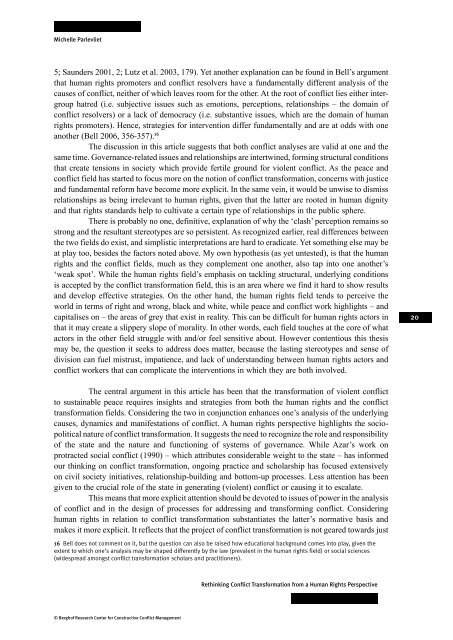Rethinking Conflict Transformation from a Human Rights Perspective
Rethinking Conflict Transformation from a Human Rights Perspective
Rethinking Conflict Transformation from a Human Rights Perspective
You also want an ePaper? Increase the reach of your titles
YUMPU automatically turns print PDFs into web optimized ePapers that Google loves.
Michelle Parlevliet<br />
5; Saunders 2001, 2; Lutz et al. 2003, 179). Yet another explanation can be found in Bell’s argument<br />
that human rights promoters and conflict resolvers have a fundamentally different analysis of the<br />
causes of conflict, neither of which leaves room for the other. At the root of conflict lies either intergroup<br />
hatred (i.e. subjective issues such as emotions, perceptions, relationships – the domain of<br />
conflict resolvers) or a lack of democracy (i.e. substantive issues, which are the domain of human<br />
rights promoters). Hence, strategies for intervention differ fundamentally and are at odds with one<br />
another (Bell 2006, 356-357). 16<br />
The discussion in this article suggests that both conflict analyses are valid at one and the<br />
same time. Governance-related issues and relationships are intertwined, forming structural conditions<br />
that create tensions in society which provide fertile ground for violent conflict. As the peace and<br />
conflict field has started to focus more on the notion of conflict transformation, concerns with justice<br />
and fundamental reform have become more explicit. In the same vein, it would be unwise to dismiss<br />
relationships as being irrelevant to human rights, given that the latter are rooted in human dignity<br />
and that rights standards help to cultivate a certain type of relationships in the public sphere.<br />
There is probably no one, definitive, explanation of why the ‘clash’ perception remains so<br />
strong and the resultant stereotypes are so persistent. As recognized earlier, real differences between<br />
the two fields do exist, and simplistic interpretations are hard to eradicate. Yet something else may be<br />
at play too, besides the factors noted above. My own hypothesis (as yet untested), is that the human<br />
rights and the conflict fields, much as they complement one another, also tap into one another’s<br />
‘weak spot’. While the human rights field’s emphasis on tackling structural, underlying conditions<br />
is accepted by the conflict transformation field, this is an area where we find it hard to show results<br />
and develop effective strategies. On the other hand, the human rights field tends to perceive the<br />
world in terms of right and wrong, black and white, while peace and conflict work highlights – and<br />
capitalises on – the areas of grey that exist in reality. This can be difficult for human rights actors in<br />
that it may create a slippery slope of morality. In other words, each field touches at the core of what<br />
actors in the other field struggle with and/or feel sensitive about. However contentious this thesis<br />
may be, the question it seeks to address does matter, because the lasting stereotypes and sense of<br />
division can fuel mistrust, impatience, and lack of understanding between human rights actors and<br />
conflict workers that can complicate the interventions in which they are both involved.<br />
The central argument in this article has been that the transformation of violent conflict<br />
to sustainable peace requires insights and strategies <strong>from</strong> both the human rights and the conflict<br />
transformation fields. Considering the two in conjunction enhances one’s analysis of the underlying<br />
causes, dynamics and manifestations of conflict. A human rights perspective highlights the sociopolitical<br />
nature of conflict transformation. It suggests the need to recognize the role and responsibility<br />
of the state and the nature and functioning of systems of governance. While Azar’s work on<br />
protracted social conflict (1990) – which attributes considerable weight to the state – has informed<br />
our thinking on conflict transformation, ongoing practice and scholarship has focused extensively<br />
on civil society initiatives, relationship-building and bottom-up processes. Less attention has been<br />
given to the crucial role of the state in generating (violent) conflict or causing it to escalate.<br />
This means that more explicit attention should be devoted to issues of power in the analysis<br />
of conflict and in the design of processes for addressing and transforming conflict. Considering<br />
human rights in relation to conflict transformation substantiates the latter’s normative basis and<br />
makes it more explicit. It reflects that the project of conflict transformation is not geared towards just<br />
16 Bell does not comment on it, but the question can also be raised how educational background comes into play, given the<br />
extent to which one’s analysis may be shaped differently by the law (prevalent in the human rights field) or social sciences<br />
(widespread amongst conflict transformation scholars and practitioners).<br />
© Berghof Research Center for Constructive <strong>Conflict</strong> Management<br />
<strong>Rethinking</strong> <strong>Conflict</strong> <strong>Transformation</strong> <strong>from</strong> a <strong>Human</strong> <strong>Rights</strong> <strong>Perspective</strong><br />
20
















